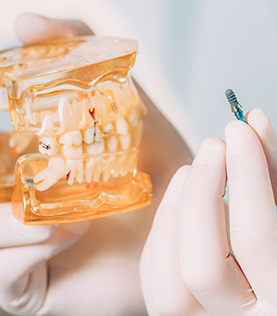
A dental implant is a long-term solution for replacing missing teeth. Your dentist places them directly into your jawbone, where they provide an artificial replacement for the root of your missing tooth or teeth. They can support crowns or dentures, in a similar way that roots support natural teeth.
A dental implant itself is a titanium screw, which is placed directly into your jawbone, replacing your missing tooth root. After it’s fitted, the bone surrounding your implant will gradually fuse to it, holding the implant firmly in place. A false tooth (a crown or denture) is then fitted to the top of the implant (the abutment), giving a natural look to your smile.
You can have a single implant, or you can have multiple ones if you need more than one tooth replaced. It is possible to have several implants fitted in the same procedure. If you have few or no teeth, the smile in a day technique might work for you. This uses four to six implants supported by a bridge.
We know people feel self-conscious if they have missing teeth. With an implant, hopefully you can get your confidence back – whether it’s in your smile, how you eat or when you talk.
n implant isn’t the only way to replace missing teeth – there are several other solutions. These include:
Your dentist will help you to decide what’s best for you. An implant isn’t the right option for everybody. It can depend on many things, including which teeth are missing, and the condition of your remaining teeth and gums.
One of the reasons people choose implants is that they’re a more permanent option than dentures. So long as you care for your implant properly, they can last as long as natural teeth. Dentures tend to last for around five to 10 years. And as they’re made to fit your mouth exactly, they can become less comfortable as your mouth changes shape over time.
Implants may also be a preferred option if you want to avoid causing any damage to your existing teeth. This can happen if you have a bridge, as sometimes it can mean cutting your natural teeth to fit them.
People might choose to have bridges because, in some circumstances, it’s a less complicated procedure than implants. They might also be needed if your dentist doesn’t think you have enough bone to fit an implant and you don’t want to have a bone graft.
Dental implants are usually fitted during two separate procedures; the first being to fit the implant itself into your jawbone, and then the second a few months later to fit the new tooth onto the implant.
You’ll usually be able to have the procedure in your dentist’s surgery, under local anaesthesia. Tell your dentist if you’re feeling particularly anxious about treatment, as they might be able to offer you a sedative to help you relax.
Dental implants are suitable for most adults who are in good general health and have healthy gums. They aren’t suitable for children and young people under 18 because the underlying bones are still growing.
Your dentist may not recommend dental implants if you:
However, each case is different. Tell your dentist about any medical problems you have, and they’ll let you know if implants are an option for you.
We will send you a confirmation within 24 hours. Emergency? Call 020-7223-5114
